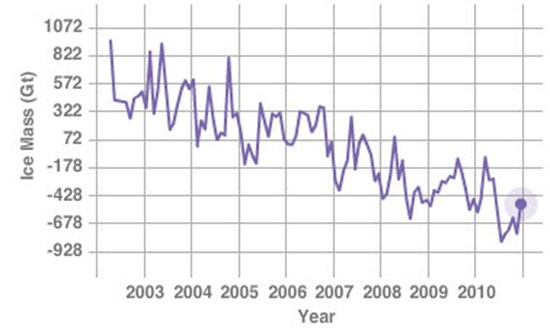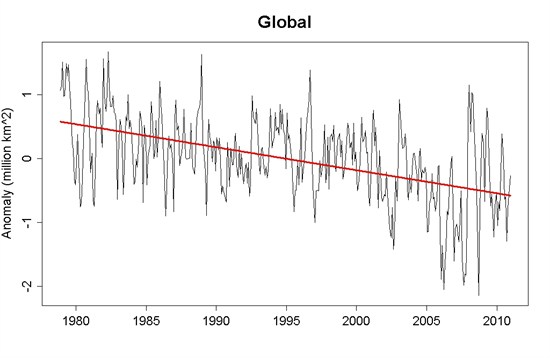When scientists talk about ice and climate change, it’s often about how quickly it’s disappearing. So recent news stories about Antarctic sea ice growing may come as a surprise.
The amount of ice in the ocean around Antarctica is indeed increasing, but this is only part of what’s going on in the Antarctic as a whole. We’ve put together six things you should know about climate change and Antarctic ice.
1. Antarctic waters are warming faster than the global average
Along with the rest of the world, the Antarctic is warming up. The Southern Ocean, which surrounds the continent of Antarctica, has been warming faster than the rest of the world’s oceans since the 1950s, at a rate of 0.17 degrees Celsius compared to a global average of 0.1 degrees. The increased rate of warming is mainly due to the way large weather systems transport heat to the poles.
2. Despite rapid warming, there’s more Antarctic sea ice
Despite rapidly warming water, the amount of ice that floats on the Southern Ocean around Antarctica – known as sea ice – is slightly increasing. On 26 September 2012, the US National Snow and Ice Data Centre (NSIDC) confirmed that Antarctic sea ice reached a record extent – a measure of sea ice cover – of 19.44 million square kilometres.
3. Scientists believe the wind is driving sea ice increase
New research released in the journal Nature Geoscience yesterday tracked Antarctic sea ice between 1992 and 2010. It suggests that trends in sea ice are closely linked to local winds. The main driver of the overall increase in sea ice is the changing strength of cold winds, which blow ice away from the coast and allow the water in between to freeze. (Although there are some differences across the continent.)
The new study says that the wind change may be down to natural climate variability, but that there is evidence that the southern hemisphere ozone hole also plays a part.
4. Most of the ice in Antarctica is on land
The new research talks about the ice floating on top of the Southern Ocean. But most of the ice in the Antarctic is actually contained within a vast expanse that covers the land mass and extends into the surrounding ocean – known as the Antarctic ice sheet.
Measurements from the Gravity Recovery and Climate Experiment (GRACE) satellite since 2002 have shown that the mass of the Antarctic ice sheet is decreasing at an average rate of 100 cubic kilometres every year – the size of a small UK city. Scientists have compared different techniques for measuring this ice loss and found good agreement between them.
The graph below, using the GRACE data, shows the rate of ice loss from the Antarctic ice sheet since 2002, relative to the 2002 to 2011 average.

Source: NASA/University of California, Irvine
5. What’s going on in the Arctic is quite different because it’s mainly ocean
While the Antarctic is a land mass surrounded by ocean, the Arctic is an ocean with land around the outside. The different geographies mean that the forces determining sea ice distribution are different. In the Arctic, floating sea ice melts as a direct result of warming water and the wind does not play such a major role. In September, Arctic sea ice reached its lowest extent since satellite records began in 1979.
6. The world is losing ice overall
Although Antarctic sea ice is growing in extent, the loss of sea ice in the Arctic outweighs this small gain. The graph below from climate science blogger Tamino shows that globally, sea ice has been decreasing steadily since 1979. The zero point on the left hand side of the graph is the average sea ice extent for the period 1979 to 2011.

Source: Tamino. Data is from US National Snow and Ice Data Center.
Together with the loss of ice mass from the Greenland and Antarctic ice sheets, this means that the earth is losing ice overall. A loss in ice cover means that the earth’s surface reflects less solar energy, reinforcing atmospheric warming. Melting ice sheets add freshwater to the oceans, contributing to sea level rise.
Focusing on the whole picture
Some media outlets have played down the consequences of climate change for declining global ice cover by focussing on the gains in Antarctic sea ice. While this has led to some confusing and at times apparently contradictory media coverage, there are some very accessible internet resources to keep up to date with the latest changes in polar ice cover. These include the National Snow and Ice Data Center (NSIDC) website, and Cryosphere Today.
The information about ice that scientists have to work with is increasing. For example, just last month a team of scientists produced the first three-dimensional map of the underside of Antarctic sea ice using a robot submarine.
Maps like these will help scientists better understand how climate change may be affecting the thickness of sea ice, as well as the area it covers. Only by considering sea and land ice in both hemispheres can we get a full picture of how the planet is responding to global warming.
This article was originally published in November 2012.

